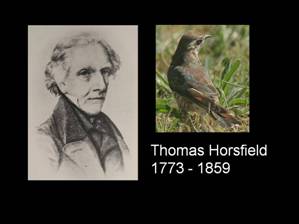
It is most satisfying to find
that ‘Horsfield’s Bushlark’ has been formally restored.
That was the name in the edition of Cayley I had as a child. Some years
ago I gave a little talk at COG entitled ‘Dr Horsfield, his cuckoo, and
the Singing Bushlark’. The story of the name for this local species
casts some light on the difficult issues in the current process of bird-naming.
The scientific name story
In 1821, Dr Horsfield, a
government medical official in Java, named a lark Mirafra javanica.
In 1847 John Gould named an Australian lark Mirafra horsfieldi ,
intending to honour Horsfield as the proposer of the genus Mirafra.
Gould would have known Dr Horsfield as a member of the zoological circle in
London, where he was curator of the East India Company Museum. Thereafter,
various other Mirafra larks were named. There are lots of them in
Africa. In 1844, Edward Blyth, curator of the Museum of the Asiatic
Society in Calcutta, named an Indian (but more widespread) lark Mirafra
cantillans [L. cantillans = ‘warbling, humming’].
By the end of the century, both horsfiedi and cantillans were
merged in javanica. Later (can’t lay my finger on the exact
dates, but certainly in Sibley & Monroe 1990, following authorities from
1970), cantillans was again split from javanica. However horsfieldi
remains in javanica, which includes subspecies extending to SE Asia.
The English name story
In 1847 Gould had used ‘Horsfield’s’
in his suggested English label for M. horsfieldi. The 1926 RAOU
checklist used ‘Horsfield’s’ for M. javanica, hence
its use in the earlier Cayleys. However, ‘Singing’ (from the
long-standing name in India for M. cantillans) was followed by some.
The RAOU committee in 1978 noted that ‘Singing’ was ‘the
usual international name’ and thought that ‘the eponymous [ie
person’s] name [was] best avoided’. Thus ‘Singing’
was recommended and taken up in Christidis and Boles 1994 (C&B1). Their
timing was terrible. As I have mentioned, C&B1 do not seem to have
laboured much over the English names issue but pretty well accepted the 1978 recs.
In the intervening 16 years, at least several authorities had split off M.
cantillans, which took with it the ‘Singing’ label. There
it was in black and white in Sibley and Monroe 1990. As a further
indignity, Handbook of the Birds of the World (HBW) 2004 uses ‘Australasian
Bushlark’, and under ‘other common names’ gives ‘Singing
Bushlark with a ‘(!)’, meaning ‘can you believe this?’.
In The Directory of
Australian Birds Schodde & Mason 1999, noted that with the split ‘Singing’
had become unavailable, and suggested that, of the alternatives, ‘the
earlier and hitherto widely-used name of “Horsfield’s Bushlark”
seems preferable’. This has now been taken up in C&B2,
and is consistent with the international English names recommendations of Gill
& Wright 2006.
The compound name issue
Elsewhere I have mentioned this,
the most serious obstacle to international consistency in English names. Not
only does the (one hopes) authoritative Gill & Wright give ‘Horsfield’s
Bush Lark’, but the most enthusiastic compounders Sibley/Monroe drop the ‘Bush’
and, in their 1993 list, offer ‘Horsfield’s Lark’.
However, this might be a special case, as various compound forms have been
around for a very long time. Moreover, there might be a reasonable view
that the Mirafra larks should have their own English name (see eg
Rasmussen & Anderson Birds of South Asia 2005 vol2 p296). That
would accord with the longstanding Indian approach, and the current Australian
one. The arguments in Gill & Wright against ‘Bush-Lark’
do not apply with the same force to ‘Bushlark’ (‘Cuckooshrike’
being acceptable, although one issue might be that bushlarks are larks, or so
we are told, with implications for indexing).
Finally, on this happy
occasion, might I express the hope that the COG chatline initiative to render ‘Horsfield’
as ‘Horsefield’ not be further pursued?
gd

